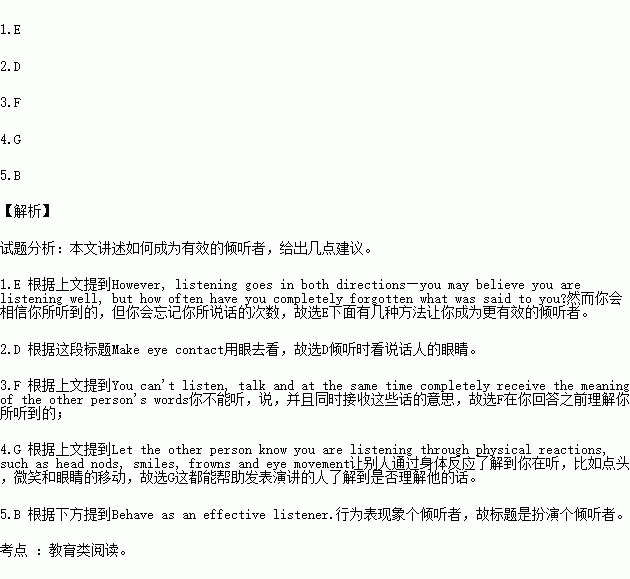题目内容
根据短文内容,从短文后的选项中选出能填入空白处的最佳选项。选项中有两项为多余选项。
We all believe we listen well and yet many times we feel others are not listening to us. However, listening goes in both directions—you may believe you are listening well, but how often have you completely forgotten what was said to you? 1.
Make eye contact.
2. when People talk, they put out visual clues that add to the conversation and meaning of their words.
Stop talking.
You can't listen, talk and at the same time completely receive the meaning of the other person's words. 3.
React without words.
Let the other person know you are listening through physical reactions, such as head nods, smiles, frowns and eye movement. 4.
Concentrate.
Concentrate on what the other person is saying. Clear your mind of other thoughts and emotions and focus on the conversation at hand. Be in the moment of that conversation, and don't think about what you want to say back.
5.
Behave as an effective listener. The more you continue to behave as a listener, the more you will be an effective listener.
A. Don't break in.
B. Act as a listener.
C. How to say back is also important.
D. Make eye contact with the person who is talking to you.
E. There are a few ways to become a more effective listener.
F. Wait your turn and take in what has been said to you before you make a reply.
G. These may also help to let the speaker know whether you are accurately (准确地) understanding his words.
In New York there are quite a few free museums for visitors. Below we explore New York’s most impressive free ones.
National Museum of the American Indian
Focusing largely on Native American culture, this museum boasts(自夸)over a million items, from crafts to traditional tools, all of which played a large part in Native American culture in past times. Located at 1 Bowling Green, the museum is free of charge. Open 10 a.m.~5p.m. Frid-Wed and 10 a.m.~8 p.m. Thurs, it’s served by subway lines 4/5 to Bowling Green.
Federal Hall
A popular one for followers of American politics, Federal Hall is the original location of the US Customs House and the place where Washington took the oath(宣誓)of office in 1789 as the first US President. Today, this building is a premier example of classical architecture. Free of charge to visitors, the museum is located at 26 Wall St, which is accessible by subway lines 2/3/4/5 to Wall St. It’s open from 9 a.m.~ 5 p.m. Mon-Fri.
New York Academy of Medicine
For the more intellectual, a trip to the New York Academy of Medicine is unmissable. With over 700,000 catalogued works, it’s the world’s second largest health library. Its biggest attraction, however, is the interesting medical equipment on display here, which is weird(古怪的) but wonderfully original. Located at 1216 Fifth Ave at 103rd St, it’s free of charge to peruse. Open 9 a.m. ~ 5 p.m. Mon-Fri, it’s served by subway line 6 to 103rd St.
Museum at Fashion Institute of Technology
The museum contains a huge permanent collection which features 200 historically significant clothes and also features works by student exhibitions. With free talks and tours on offer, this museum is a great place without spending a cent. Located at Seventh Ave at 27the St by subway line 3, this free museum---undoubtedly the most fashionable one in New York --- is open Tues-Fri 12 a.m. ~8 p.m. and Sat 10 a.m.~ 5 p.m..
1.If you are interested in Native American culture, where would you probably go?
A. To 1 Bowling Green.
C. To 1216 Fifth Ave.
B. To Seventh Ave at 27th St.
D. To 103rd Wall St.
2.If you take the subway line 4 to 26 Wall St, you can enjoy __________. |
A. reading medical books
C. the art of costume
B. the art of architecture
D. the ancient tools
3.Which of the following about the four museums mentioned in the text is NOT true?
A. They are all located in New York.
C. They are all symbols of power.
B. They are all free of charge.
D. They are all accessible by subway.

